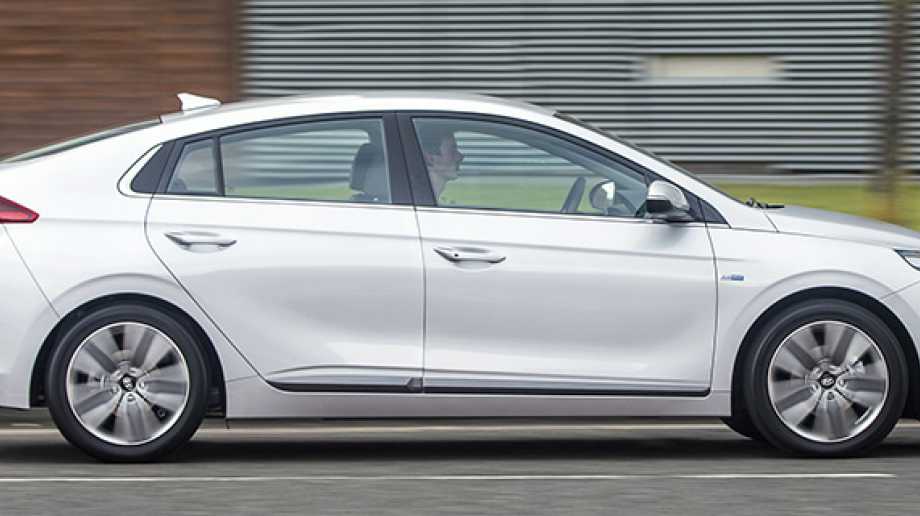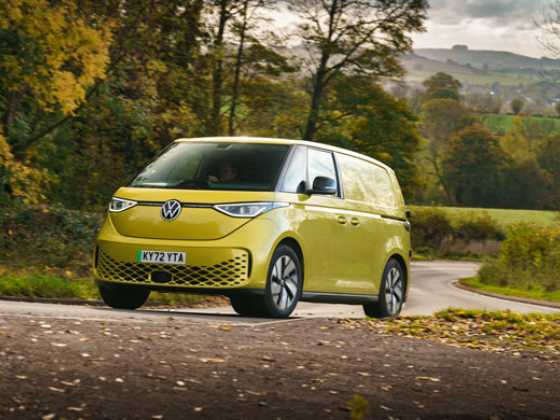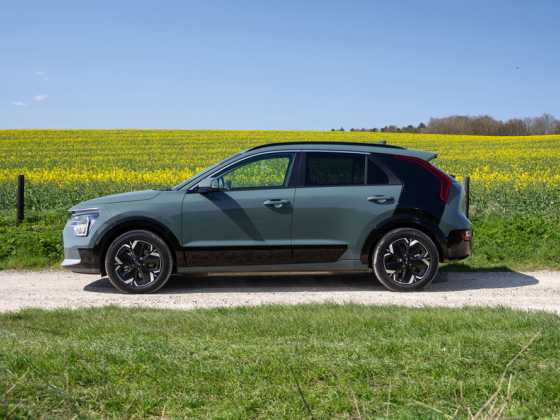Road test: Hyundai Ioniq Plug-in Hybrid Premium SE

The Plug-in Hybrid is the last of Hyundai’s Ioniq family to arrive, but does it offer the best benefits of all-electric and hybrid running? Richard Gooding tops up his knowledge on the South Korean newcomer
What is it?
First seen at the Geneva motor show in spring 2016 in electric, hybrid and plug-in hybrid forms, the Hyundai is the first car range to offer a choice of three electrified powertrains in one bodystyle, ensuring, as Hyundai claims, ‘low- to zero-emission mobility accessible to everyone’.
The Ioniq faces a range of competitors, varying from hybrids including Toyota’s ubiquitous but very capable Prius and in‑house rival the Kia Niro, to all-electric cars such as the BMW i3 and new Nissan Leaf.
The Ioniq Hybrid and Electric were the first to arrive, while the plug-in hybrid was launched in the second quarter of 2017, and takes on the plug-in versions of the Niro and Prius head-on.
How does it drive?
Sharing the same quietly handsome five-door body with its all-electric and hybrid relatives, the Ioniq bears similar wind-cheating lines to the Toyota Prius, but with a drag‑coefficient figure of just 0.24, the Hyundai is one of the most aerodynamically effective cars currently on sale.
That’s also helped by active air flaps in the front grille, while blue exterior and interior accents are also shared with the standard Ioniq Hybrid.
The cabin is the same, too, and that’s no bad thing. Premium-feeling materials feature in all three Ioniqs, with plenty of leather‑trimmed and soft-touch materials.
The same eight-inch colour touchscreen infotainment system as on other Ioniqs gives the same clear and responsive experience, and incorporates features from both, giving fuel economy, battery charge, EV range, as well as fuel station and chargepoint locations.
The seven‑inch TFT display ahead of the driver also imparts information such as electric-only and fuel range – as well as energy flow – so you’re under no illusion and are in charge (pun intended) at all times of how the car is driven.
And that drive is, unsurprisingly, very similar to its brethren. Powered by the same 103bhp 1.6-litre GDI petrol engine from the ‘Kappa’ range of units as the Ioniq Hybrid, the Plug-in’s powertrain boasts a larger‑capacity 44.5kW/59bhp electric motor allied to an 8.9kWh lithium-ion polymer battery.
Driven through a six-speed dual clutch transmission rather than the Ioniq Electric’s single-speed reduction gear, maximum system output is 138bhp, while torque is 185lb ft / 265Nm at 4,000rpm.
Performance is almost identical to the Ioniq Hybrid, with 62mph coming up in 10.6 seconds, 0.2 seconds quicker than the non-plug-in car. So swift rather than fast, but that was always going to be the case – blessed with a more relaxing demeanour, the Ioniq is just that kind of car.
At cruising speeds, the Ioniq Plug-in as hushed as the Hybrid, and makes for a comfortable and relatively quiet motorway accomplice. The Ioniq Plug-in has the same failsafe, tidy handling as its all-electric and hybrid siblings, and while it’s not the most involving car, there are pockets of fun to enjoy, most notably in EV operation.
Hyundai quotes an electric-only range of 39 miles, and that alone makes it more enjoyable to drive than the standard Ioniq Hybrid.
With an average EV distance of over 30 miles during our test, we found it more usable in everyday situations. Running on electric‑only power more often, we frequently saw ‘99.9mpg’ on the car’s multifunction display.
The Hybrid car’s petrol engine cuts in far too early, and that’s not the case here.
Three driving modes – EV, HEV Hybrid and Sport – can be selected, and a button on the centre console saves the battery charge for all-electric use in urban areas. As with other plug-in vehicles, it’s best to use the car’s petrol engine at higher speeds.
How economical is it?
Unlike the Ioniq Hybrid, the Plug-in car rolls on 16-inch alloy wheels, an inch larger than the non-replenishable car.
But because of its top-up capability, the Ioniq Plug-in boasts a better combined cycle fuel economy figure. Hyundai claims an official 256.8mpg on the NEDC cycle – compared to the Hybrid’s 83.5mpg.
Through diligent use of a 7kW wallbox topping up the battery every evening, we achieved a ‘real-world’ average of 83.5mpg, which although the same as the standard Ioniq Hybrid’s official figure, is around 17.5mpg more than we eked out in everyday driving conditions.
The car itself features a 7kW on‑board charger, and from a 16A wallbox, topping up the battery takes around two hours and 15 minutes.
Hyundai have also recently announced the availability of a cost-free Pod Point home charger with the purchase of an Ioniq Plug-on or Electric, previously a £300 option.
Unique to the Ioniq Plug-in Hybrid, the navigation system has ‘ECO-DAS’ technology with predictive energy management, which optimises the battery charge and discharge, as well as a coasting guide.
What does it cost?
Like the all-electric version, the Ioniq Plug-in is only available in Premium and Premium SE trims, and not the standard Hybrid’s entry‑level SE grade.
Before the government’s £2,500 Plug-in Car Grant (PiCG), the Plug-in Premium costs £27,495, the range-topping Premium SE – our test car’s trim – starts from £29,295. Deduct the PiCG and the price drops to £24,995 and £26,795 respectively.
Perhaps the plug-in Hyundai’s most direct rival in terms of space, looks, and concept, the Toyota Prius Plug-in is considerably more expensive. The Japanese car starts at £29,195 for the Business Edition Plus with the PiCG deducted, rising to £31,395 for the high-spec Excel model.
Premium spec offers 16-inch alloy wheels, an 8-inch integrated satellite navigation unit with Bluetooth, Apple CarPlay and Android Auto connectivity, cruise control, heated seats and steering wheel, LED head and tail lights, rear park assist system, and wireless smartphone charging.
A host of technology keeps safety in check, while moving up to Premium SE grade adds blind spot detection and a front park assist system. Other additional features include alloy pedals, electrically-adjustable memory-function driver’s seat, front seat ventilation, and rain sensing wipers.
How much does it cost to tax?
The Ioniq Plug-in Hybrid has CO2 emissions of 26g/km (4g/km more than the Prius Plug-in) which allows it to sit in the first band of VED which costs. With the £10 alternative fuel discount applied, the Ioniq Plug-in is exempt from VED in the first year, and costs £130 per year thereafter.
That’s a potential £120 saving in the first year when compared to the non-socketed Ioniq, but it’s worth remembering that car is a fair bit cheaper to buy in the first place. All Ioniq Plug-ins currently attract a nine per cent Benefit in Kind rate, around half that of the hybrid car.
Why does my fleet need one?
Our admiration for the Ioniq Hybrid is heightened by the Plug-in model. While we’d still take the all-electric version of Hyundai’s family car over either of its petrol-electric sisters, the Ioniq Plug-in offers a good compromise between all-electric running and range, and the ‘safety blanket’ of conventionally-fuel back-up.
While it wasn’t as economical as the Toyota Prius Plug-in in real-world use, the Ioniq is cheaper, has less challenging looks, is just as practical and is less daunting inside if you’re not used to electrified powertrain driving.
Just like the Ioniq Hybrid and Ioniq Electric, the Ioniq Plug-in is competitively priced, comfortable and well‑specified. It also enjoys the same easy-to-drive nature, and feeling of a ‘normal’ car, one of the characteristics Hyundai was striving for. The South Korean company has scored with the final iteration of the Ioniq.
As with its EV and petrol-electric sisters, there is a five-year unlimited mileage warranty package (with additional high voltage battery cover of eight years or 125,000 miles), and although it costs more outright than the all‑electric Ioniq post‑PiCG deduction, the security of the petrol engine reserve will comfort some.
A more enjoyable car than the standard Ioniq Hybrid, the Ioniq Plug-in has even greater appeal to environmentally‑attuned fleets.









